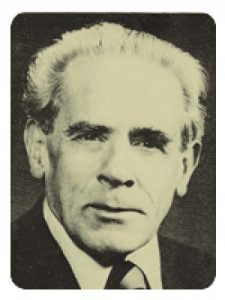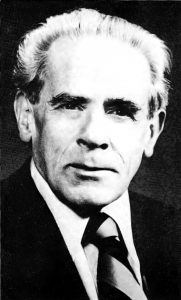
Folch was born in Barcelona, Spain. His father Rafel Folch was a lawyer and a Catalan poet, and his mother Maria Pi a teacher. As his mother liked and spoke French, Folch went to high school at the Lycée Français of Barcelona, from which he graduated in 1927. He then undertook Medicine studies and received an M.D. degree from the University of Barcelona Medical school in 1932.
Folch's clinical training at university included a period as an intern in the surgical clinic of Dr. Antoni Trias and as the sole physician in Almedret, a small Catalan village of 800 people. In contrast, the basic sciences consisted mainly of lectures with little opportunity for hands-on laboratory experience. Folch was fortunate to have the opportunity to study at the Institute of Physiology in Barcelona, which was founded by his cousins August Pi Sunyer and Jesus Maria Bellido, and was dedicated to carrying out basic research using contemporary methods and ideas. He worked as an assistant to another cousin Cesar Pi Sunyer and by the time he received his M.D. degree, they had jointly published four papers on glycogen synthesis in three different languages (German, French, and Spanish). Folch also studied blood glucose and lactic acid metabolism under the direction of the man he considered his scientific mentor, Professor Rosend Carrasco Formiguera. He was the person who particularly encouraged the young Folch in his research. Folch's experiences at the Institute of Physiology intensified his interest in physiology and in clinical questions, particularly as they related to metabolic problems. Thanks to Carrasco's contacts, Francisco Duran Reynals, a biochemist at the Rockefeller Institute in New York, became interested in Folch and arranged for him work at the Institute as a volunteer.
In 1936, just before the Spanish Civil War broke out, he was offered the position of research fellow at the Rockefeller Institute in New York, and he took the post. At the insistence of his family (who had fought for the defeated Republican side—his brother Albert and sister Núria fled to Mexico and his other brother Frederic spent a few months in prison after returning from exile in France), Folch decided to stay in the United States after the Spanish Civil War ended.
Folch began his time at the Rockefeller Institute in 1936 as a volunteer assistant. A year later he obtained a formal assistant position, and later on, became an associate on the scientific staff of the Hospital of the Rockefeller Institute for Medical Research in Donald Van Slyke’s department. Folch’s first assignment was a project with Dr. Irvine Page on pituitary hormone disturbances. Folch's role was to analyse plasma lipids in these disorders, and soon realized that the common method of extracting lipids with petroleum ether was problematic in that the extraction was not quantitative and the extract contained non-lipid contaminants. He then devised a procedure that involved precipitation of lipids and proteins with colloidal iron and removal of most of the non-lipid components with water, which solved the contamination problem.
During these first investigations he co-signed a paper with Donald Van Slyke on an improved manometric method for carbon analysis. Using this newly developed method, he characterized the isolated "cephalin" fraction from brain tissue that afterwards, Johannes Thudichum (the nineteenth-century founder of the field of structural neurochemistry) considered pure phosphatidyl ethanolamine. Folch showed that the amount of carbon and of amines were not consistent with Thudichum's formula. This research led to Folch's first publication on brain lipids in 1941 and was followed over a period of several years by a series of influential papers showing that cephalin was not a single lipid but rather a mixture of three lipids (phosphatidyl ethanolamine, phosphatidyl serine, and inositol). Folch was the first to elucidate the structure of phosphatidyl serine. Furthermore, he isolated subsequently mono-, di- and triphosphoinositides.
In 1944, Folch was appointed director of the new Biological Research Laboratory at the McLean Hospital (a division of Massachusetts General Hospital) and assistant professor of biological chemistry at Harvard Medical School to develop a program in Neuroscience. His fundamental philosophy was that, to understand the structural chemistry of the brain, it was necessary to identify all brain components. Thus, he developed mild procedures for quantitative extraction of brain lipids leading to the classic method using a chloroform-methanol mixture and a phase partition with water which resulted in quantitative extraction of tissue lipids and removal of water-soluble contaminants. This method became one of the most highly cited papers of the 1950s and was recently featured no. 9 in the list of the most highly cited papers in the history of science. The technique he developed for purifying the brain lipids is still referred to as "Folching" and is one of the most cited papers in the history of biochemistry. The‘Folch’ solution contains chloroform and methanol, usually in a 2:1 (vol/vol) ratio. One of its uses is in separating polar from nonpolar compounds, for example separating nonpolar lipids from polar proteins and carbohydrates in blood serum. More recently, citations have diminished likely due to the incorporation of the technique into the common English vocabulary as the verb "To Folch" to describe the Folch's technique for extracting tissue.
Folch successfully used his method to examine changes in brain lipids and proteins during development or diseases. His method led to the identification of myelin proteolipid (defined as a new type of lipoproteins) in white matter and water-soluble glycolipids (named strandin at that time but now recognized as gangliosides) in grey matter. Until the end of his career, the characterization of proteolipids was a major focus of Folch's work and interest.Folch's isolation procedure provided the basis for later studies of acylated proteins and gangliosides.
Folch is considered to be one of the founders of the chemistry of complex lipids as well as a leader in the development of neurochemistry. He was one of the founders of the American Society for Neurochemistry and of the International Society for Neurochemistry. In 1956, Folch became the first Professor of Neurochemistry at Harvard Academy of Arts and Sciences. In 1978, he was elected to the United States National Academy of Sciences. He was also honorary professor in the Faculty of Medicine at the University of Barcelona, and was awarded honorary degrees by the University of Montpellier, France, and by the University of Chile, Santiago. After his retirement in 1977, he became Professor of Neurochemistry Emeritus and continued to be active as an honorary biochemist at McLean Hospital until his death.
Folch died in Boston, Massachusetts on October 3, 1979 at 69 years of age.
Personal life
In 1945, Folch married Willa Babcock, who was also a scholar in her own right (in the subject of Romance languages) and would later become the academic dean of Tufts University. The couple had three children.
When he moved to America and married Willa, he decided to hyphenate his paternal and maternal last names, so that his children would bear his full family heritage: "Folch-Pi". His last names are often mispronounced "Foltsch Pie" but the correct Catalan pronunciation is "Folk Pea". In the Spanish tradition of providing two identifying surnames, he often signed using both his maternal and paternal surnames.
Awards and Honours
-
Member of the American Academy of Arts and Sciences (1956).
-
Member of the United States National Academy of Sciences (1978).
-
Awarded honorary professorship by the Faculty of Medicine of the University of Barcelona (Spain).
-
Awarded honorary degree by the University of Montpellier (France).
-
Awarded honorary degree by the University of Chile, Santiago (Chile).
-
Awarded medal as honorary councillor of CSIC (Supreme National Council for Scientific Research, Spain).
Main works
- Schneider, H. A. ; Folch i Pi, J. An amino acid constituent of ox brain cephalin. J. Biol. Chem. 137:51-62.
- Woolley, D. W.; Folch i Pi, J. Inositol, a constituent of a brain phosphatide. J. Biol. Chem. 142:963-64.
- Brain cephalin, a mixture of phospatides. Separation from it of phosphatidyl serine, phospatidyl ethanolamine and a fraction containing an inositol phosphatide. J. Biol. Chem. 146:35-44. The chemical structure of phosphatidyl serine. J. Biol. Chem. 174:439-50.
- Brain diphosphoinositide, a new phosphatide having inositol metadiphosphate as a constituent. J. Biol. Chem. 177:505-19.
- Lees, M.; Folch i Pi, J. Proteolipids, a new type of tissue lipoproteins. Their isolation from brain. J. Biol. Chem. 191:807-17.
- Arsove, S.; Meath, J. A.; Folch i Pi, J. Isolation of brain strandin, a new type of large molecule tissue component. J. Biol. Chem. 191:819-31.
- Ascoli, I.; Lees, M.; Meath, J. A.; LeBaron, F. N.; Folch i Pi, J. Preparation of lipide extracts from brain tissue. J. Biol. Chem. 191:833-41.
- Waksman, B. H.; Porter, H., Lees, M. B.; Adams, R. D; Folch i Pi, J. A study of the chemical nature of components of bovine white matter effective in producing allergic encephalomyelitis in rabbits. J.Exp. Med. 100:451-71.
- Composition of the brain in relation to maturation. In Biochemistry of the Developing Nervous System, ed. H. Waelsch, pp. 121-36. New York: Academic Press.
- LeBaron, F. N.; Folch i Pi, J. The isolation from brain tissue of a trypsinresistant protein fraction containing combined inositol, and its relation to neurokeratin. J. Neurochem. 1:101-108.
- Porter, H.; Folch i Pi, J. Cerebrocuprein I, a copper-containing protein isolated from the brain. J. Neurochem. 1:260-71.
- Lees, M.; Sloane Stanley, G. H.; Folch i Pi, J. A simple method for the isolation and purification of total lipids from animal tissues. J. Biol. Chem. 226:497-509.
- Lees, M.; Sloane Stanley, G. H.; Folch i Pi, J. The role of acidic lipides in the electrolyte balance of the nervous system of mammals. In Metabolism of the Nervous System, ed. D. Richter, pp. 174-99. London: Pergamon Press.
- Lees, M.; Folch i Pi, J. Studies on the brain ganglioside strandin in normal brain and in Tay-Sachs disease. AMA J. Dis. Child. 97(part II):730-38.
- Casals, J.; Pope, A.; Meath, J. A.; LeBaron, F. N.; Lees, M.; Folch i Pi, J. The chemistry of myelin development. In Biology of Myelin. ed. S. Korey, pp. 122-37. New York: P. B. Hoeber Press.
- Lees, M. B.; Folch i Pi, J. A study of some human brains with pathological changes. In Chemical Pathology of the Nervous System, ed. J.Folch-Pi, pp. 75-82. Oxford: Pergamon Press.
- Webster, G. R. ; Folch i Pi, J. Some studies on the properties of proteolipids. Biochim. Biophys. Acta. 49:399-401.
- Lees, M. B.; Carr, S.; Folch i Pi, J. Purification of bovine brain white matter proteolipids by dialysis in organic solvents. Biochim. Biophys. Acta. 84:464-66.
- Matsumoto, M.; Matsumoto, R.; Folch i Pi, J. The chromatographic fractionation of brain white matter proteolipids. J. Neurochem. 11:829-38.
- Quarles, R.; Folch i Pi, J. Some effects of physiological cations on the behavior of gangliosides in a chloroform:methanol:water biphasic system. J. Neurochem. 12:543-53.
- Tenenbaum, D.; Folch i Pi, J. The preparation and characterization of water soluble proteolipid protein from bovine brain white matter. Biochim. Biophys. Acta. 115:141-47.
- Sherman, G.; Folch i Pi, J. Rotatory dispersion and circular dichroism of brain proteolipid protein. J. Neurochem. 17:597-605.
- Stoffyn, P.; Folch i Pi, J. On the type of linkage binding fatty acids present in brain white matter proteolipid apoprotein. Biochem. Biophys. Res. Commun. 44:157-61.
- With P. J. Stoffyn. Proteolipids from membrane systems. Ann. N. Y. Acad. Sci. 195:86-107.
- Sakura, J. D.; Folch i Pi, J. Preparation of the proteolipid apoprotein from bovine heart, liver and kidney. Biochim. Biophys. Acta. 427:410-27.
For more information
- Jordi Folch i Pi, L'home i la obra (1911 -1979) por Francesc González i Sastre. Pertenece a la publicación Record de Josep Puche i Álvarez, Conrad Xalabarder i Puig, Antoni Esteve i Subirana, Pere Domingo i Sanjuán, Jordi Folch i Pi. Instituto de Estudios Catalanes-Sociedad Catalana de Biología, 1980.
- A Biographical Memoir by Majorie B. Less and Alfred Pope. Biographical Memoirs, Vol. 79. Published by The national Academy Press, Washington, D.C.
Agradecimientos
This biography has been compiled from information collected on December 15 , 2015 Wikipedia having incorporated new information pertaining to the biography written by Francisco González Sastre was posted in Record de Josep Puche i Álvarez, Conrad Xalabarder i Puig, Antoni Esteve i Subirana, Pere Domingo i Sanjuán, Jordi Folch i Pi published by the Institute of Catalan Studies and the Catalan Society of Biology in 1980.

